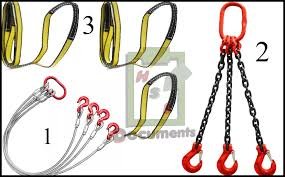When it comes to lifting heavy or delicate objects in industries like construction, shipping, logistics, or warehousing, slings are indispensable tools. They help workers move loads efficiently while ensuring safety. However, not all slings are created equal. Depending on the nature of the load and the environment, using the wrong sling can lead to accidents, injuries, or product damage.
In this comprehensive guide, we’ll explore the three different types of slings commonly used across industries: chain slings, wire rope slings, and synthetic slings. You’ll learn how they work, where to use them, their pros and cons, and how to choose the right one for your task.
Chain Slings
What Are Chain Slings?
Chain slings are made from high-strength alloy steel. They are known for their durability and are widely used in environments where loads are extremely heavy or hot, such as steel mills, foundries, and construction sites.
Features:
-
Extremely strong and durable
-
Heat-resistant up to 1000°F (537°C)
-
Can be adjusted in length using hooks or shortening clutches
Best Use Cases:
-
Lifting steel coils, pipes, or heavy machinery
-
Environments with high heat or harsh chemicals
-
Tasks that require repeated lifting of heavy loads
Pros:
-
Long lifespan
-
High load capacity
-
Can be repaired if damaged
Cons:
-
Heavier than other slings
-
Not ideal for delicate or painted surfaces (may cause scratches)
-
More expensive upfront
Wire Rope Slings
What Are Wire Rope Slings?
Wire rope slings are constructed from multiple strands of steel wire twisted into a helix. They offer a good balance of strength and flexibility, making them suitable for a wide variety of lifting applications.
Features:
-
Made from galvanized or stainless steel
-
Flexible yet strong
-
Available in single or multi-leg configurations
Best Use Cases:
-
Marine and offshore operations
-
Construction sites and cranes
-
General-purpose lifting where flexibility is needed
Pros:
-
Resistant to abrasion and corrosion (with proper coating)
-
Can handle heavy loads and rugged conditions
-
More flexible than chain slings
Cons:
-
Can kink or fray if not handled properly
-
Requires regular inspection
-
Not suitable for sharp edges without protection
Synthetic Slings
What Are Synthetic Slings?
Synthetic slings are made from synthetic fibers like nylon or polyester. They are lightweight and ideal for lifting delicate loads that require surface protection.
Features:
-
Available as flat web slings or round slings
-
Color-coded for load capacity identification
-
Highly flexible and easy to store
Best Use Cases:
-
Lifting glass, painted equipment, or finished materials
-
Aerospace, automotive, and electronics industries
-
Jobs that require minimal abrasion and surface damage
Pros:
-
Lightweight and easy to handle
-
Non-abrasive and won’t scratch surfaces
-
Cost-effective for light to medium loads
Cons:
-
Not heat-resistant
-
Can be easily cut or damaged
-
Absorbs moisture (nylon) which can affect performance
Comparison Table: Three Types of Slings
| Feature | Chain Slings | Wire Rope Slings | Synthetic Slings |
|---|---|---|---|
| Strength | Excellent | Very Good | Moderate |
| Flexibility | Moderate | Good | Excellent |
| Surface Protection | Poor | Moderate | Excellent |
| Cost | High | Moderate | Low |
| Heat Resistance | Excellent | Good | Poor |
| Weight | Heavy | Moderate | Very Light |
| Durability | Very High | High | Moderate |
How to Choose the Right Sling
Choosing the correct sling for the job is critical to ensure safety, efficiency, and load protection. Here’s what you should consider:Load Type: Sharp edges or delicate surfaces may require synthetic slings with corner protectors.Load Weight: Use chain or wire rope slings for extremely heavy items.Environment: High heat or chemical exposure requires durable materials like steel.Frequency of Use: For repeated heavy-duty tasks, chain slings are more economical in the long run.Storage and Handling: If ease of handling is a priority, synthetic slings are your best option.
Safety Tips for Sling Use
Regardless of the sling type, always follow these safety tips:
-
Inspect Before Use: Look for signs of wear, corrosion, or damage.
-
Never Exceed Load Limits: Always check the sling’s WLL (Working Load Limit).
-
Use Padding: Especially with synthetic slings to prevent cuts or frays.
-
Store Properly: Keep slings in a clean, dry area away from sunlight and chemicals.
-
Follow Manufacturer Guidelines: Only trained personnel should operate lifting equipment.
Conclusion
Understanding the three different types of slings—chain, wire rope, and synthetic—is vital for safe and efficient lifting operations. Each sling type has unique features and ideal use cases:
-
Chain slings offer strength and durability for the toughest conditions.
-
Wire rope slings balance flexibility with rugged performance.
-
Synthetic slings are perfect for delicate, lightweight, or surface-sensitive loads.
By evaluating your lifting needs and working environment, you can choose the right sling to ensure safety, protect the load, and increase productivity.
FAQs
What is the strongest type of sling?
Chain slings are the strongest and most durable, ideal for heavy-duty and high-heat applications.
Can synthetic slings be used outdoors?
Yes, but they should be protected from sharp edges, extreme heat, and UV exposure for longer lifespan.
How often should I inspect slings?
Slings should be visually inspected before each use and undergo thorough inspections periodically, depending on usage frequency.
Can wire rope slings be repaired?
Minor damage may be repaired by professionals, but severe damage requires replacement for safety.
What sling type is best for fragile items?
Synthetic slings, particularly nylon or polyester web slings, are ideal for lifting delicate or painted surfaces.





